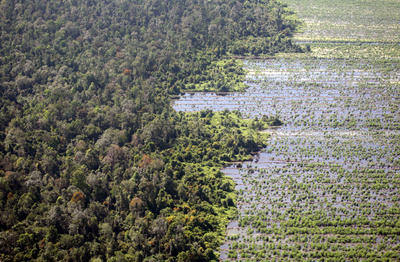The moratorium contributes to the Indonesian government’s program for reducing carbon emissions from deforestation and forest degradation (REDD+). It also aims to provide a degree of legal certainty in land use governance.
In 2010 the Corruption Eradication Commission (KPK) undertook a study on forestry policies and systems, which found that unclear legal definitions and boundaries of forest areas are perceived to be a key reason for chaotic land use management. This chaos invariably leads to a significant increase in deforestation. The KPK report said that this legal uncertainty, coupled with a lack of consistency and procedural fairness in designating forest areas, means the Ministry of Forestry has been unable to secure 88.2 per cent of designated forest areas (more than 105.8 million hectares).
The conclusions of the KPK report were foreshadowed in a 2009 study by the Indonesian Ministry of Forestry, which concluded that one of the indirect causes of deforestation is the difficulty of controlling the boundaries of production and protected forests, leaving them vulnerable to illegal logging, mining and conversion.
To date it is not uncommon for national and sub-national governments and various ministries (forestry; agriculture; energy and natural resources; public works) to have overlapping jurisdiction over state forests and peat lands. This often results in contradictory policies on land use, including processes for obtaining permits.
It is clear that the effectiveness of the forest conversion moratorium and or REDD+ in general depends on the multiple sectors and actors that use the land.
The REDD+ taskforce, which has a mandate to oversee the moratorium, has achieved some initial progress in this area. By working with different agencies and sectors, it has produced an indicative map (MIM), which outlines the areas covered by the moratorium. Updated every six months, this map will help avoid confusion and create legal certainty.
Yet the future of the moratorium and the REDD+ strategy requires more than reconciling legal uncertainty. The initiative needs to enlist the support and engagement of businesses, individual actors and layers of government that are influential in causing changes in the patterns of land use.
The forestry, agriculture, mining and infrastructure sectors are key players in Indonesia’s development. Involving them will be critical to the success of the moratorium and REDD+. To do so, the REDD+ task force must clearly lay out the subsequent steps in the moratorium so these sectors can adjust.
For instance, there is a need to further improve data quality and transparency to show protected and unprotected areas, including fallow and degraded lands. The World Resource Institute (WRI) welcomed the release of the current map, calling it an important step toward transparency. Yet the WRI criticised the map because the additional data provided were incomplete, did not include metadata, were difficult to download, and were not up to date. For this reason the WRI urged the release of technically sound, legally accurate, and up-to-date spatial data, including license and permit data, which should be independently reviewed and continuously improved. Without such data, it is impossible for the government to enforce the moratorium and for the private sector to invest in areas that will not replace forests or peat lands.
Providing positive incentives to give up unsustainable practices is yet another way of enlisting the support of relevant sectors and actors. The private sector, communities and local governments currently have little direct incentive to manage and conserve natural ecosystems, including forests and peat lands.
One way of making sustainability more attractive is to provide market access for sustainable products. Another is to use the REDD+ fund to encourage better forest and land use management. But these incentives may not be able to compete with big investments in large-scale developments, which lead to greater exploitation of forest and peat land resources. These investments are largely responsible for changing Indonesia’s land use patterns.
In 2006, the World Bank argued that positive incentives must go hand-in-hand with forest law enforcement and governance initiatives in order to increase the costs of non-compliance. But as the Bank argues, this approach will only work if the incentives are large enough to result in long-term investment in forests and production facilities.
A little more than a year into the two-year forest conversion moratorium, Indonesia needs to take stock. Achieving better land use and forest management in a developing economy is a great challenge that can only be met if Indonesia continues to increase legal certainty and develop options and incentives for sustainable practices.
Failure to address these issues may hinder the development and implementation of the moratorium and the overall REDD+ program. Indonesia has an opportunity to develop its economy in a greener and more sustainable way, and it cannot afford to let that opportunity slip.
Fitrian Ardiansyah is a doctoral candidate at the Australian National University, and the recipient of the Australian Leadership Award and Allison Sudradjat Award.
A version of this article was first published by the CoalAsia and OGE Asia Magazines.

